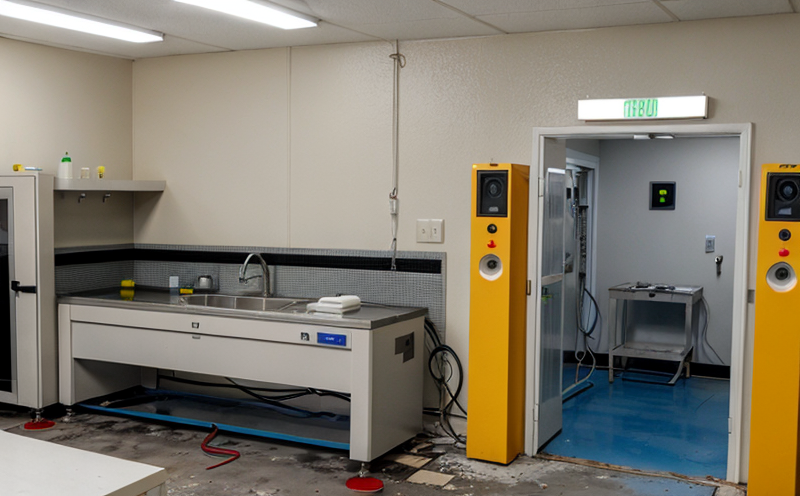ISO 7503-1 Evaluation of Surface Contamination by Direct Counting
The ISO 7503-1 standard outlines a method for evaluating surface contamination through direct counting. This technique is pivotal in ensuring the safety and compliance of facilities dealing with radioactive materials, such as nuclear power plants, medical facilities, and research laboratories.
Direct counting involves the use of a scintillation detector to measure alpha, beta, gamma, or neutron radiation emitted by the surface contamination. The process begins with thorough preparation of the sample, ensuring that it is representative of the area being tested. This may involve cleaning the surface and removing any loose material, which could otherwise skew the results.
The ISO 7503-1 protocol requires specific apparatus to ensure accurate readings. These include a scintillation detector calibrated according to the radiation type being evaluated. Calibration is crucial as it ensures that the instrument provides precise measurements under varying environmental conditions. The standard also specifies the need for a reference source of known activity, which allows for better calibration and validation.
The methodology involves placing the sample on a stable platform with minimal movement to ensure accurate readings. Once in place, the detector is activated, and it counts the particles emitted from the surface. The count rate is then measured over a specified time period, typically 30 minutes for alpha emitters, 15 minutes for beta emitters, and longer for gamma emitters.
The results are analyzed to determine compliance with regulatory limits set by international standards such as ISO, IAEA, EPA, or other relevant bodies. The standard provides detailed criteria for acceptance and rejection of the sample based on these counts. For instance, a count exceeding the specified threshold may indicate unacceptable levels of contamination, necessitating further cleaning or remediation.
This method is particularly useful in environments where low-level radiation poses significant risks to personnel and the surrounding area. The direct counting technique allows for real-time monitoring, ensuring that contamination levels are kept within safe limits. It also facilitates early detection of potential issues, enabling timely corrective actions.
In summary, ISO 7503-1 provides a robust framework for evaluating surface contamination, offering a reliable method to ensure compliance with industry standards and regulatory requirements. Its precision is vital in protecting personnel health and the environment from the adverse effects of radiation exposure.
Scope and Methodology
The ISO 7503-1 standard applies to the evaluation of surface contamination by direct counting, focusing on alpha, beta, gamma, and neutron emitters. The scope includes facilities handling radioactive materials in various sectors such as nuclear power plants, medical facilities, and research laboratories.
The methodology described in ISO 7503-1 involves several key steps: sample preparation, instrument calibration, and measurement of count rates over a specified period. Calibration is critical to ensure accurate readings across different environments and conditions. The standard specifies the use of reference sources for this purpose.
For alpha emitters, the recommended counting time is 30 minutes, while beta emitters require 15 minutes. Gamma emitters have longer measurement periods due to their lower energy levels. Neutron emitters are generally evaluated using thermal neutron detectors and have specific protocols for handling and measuring.
The standard also provides detailed acceptance criteria based on the count rates obtained from direct counting. These criteria ensure that the sample meets regulatory limits set by various international standards, including ISO, IAEA, EPA, and others. Compliance with these standards is essential for maintaining safety and ensuring operational excellence in radiation management.
Throughout the process, meticulous attention to detail is required to minimize errors and ensure accuracy. This includes proper handling of samples, precise calibration of instruments, and adherence to standardized procedures. The ultimate goal is to provide reliable data that can be used to make informed decisions about contamination levels and necessary actions.
Industry Applications
The ISO 7503-1 method finds extensive applications in sectors dealing with radioactive materials. Nuclear power plants, for instance, use this technique to monitor the safety of their facilities and personnel. In medical facilities, it helps ensure that radiation therapy equipment is safe for patients and staff.
Research laboratories also rely on ISO 7503-1 to maintain compliance with regulatory requirements. This ensures that experimental setups are free from unacceptable levels of contamination, which could interfere with research outcomes or pose health risks.
The technique's precision is particularly valuable in environments where low-level radiation requires careful monitoring. By providing real-time data on contamination levels, ISO 7503-1 supports continuous improvement and operational excellence. This aligns with broader industry goals of safety, efficiency, and regulatory compliance.
For quality managers and compliance officers, the standard offers a clear framework for evaluating surface contamination. It provides consistent methods that can be applied across different facilities, ensuring uniformity in practice and results. In R&D environments, the method supports innovation by enabling safe experimentation with radioactive materials.
Why Choose This Test
The ISO 7503-1 evaluation of surface contamination by direct counting offers several advantages over other testing methods. Its precision and reliability make it a preferred choice for facilities handling radioactive materials.
The method provides real-time data on contamination levels, enabling timely corrective actions if necessary. This ensures that radiation exposure is kept within safe limits, protecting personnel and the environment. The direct counting technique also facilitates early detection of potential issues, allowing for proactive management of contamination risks.
Compliance with international standards such as ISO 7503-1 is crucial for maintaining safety and operational excellence in radiation management. This standard ensures that facilities meet regulatory requirements, thereby reducing the risk of non-compliance penalties and reputational damage.
The method's precision and reliability are particularly valuable in environments where low-level radiation requires careful monitoring. By providing consistent results across different facilities, ISO 7503-1 supports uniformity in practice and outcomes. This aligns with broader industry goals of safety, efficiency, and regulatory compliance.
For quality managers and compliance officers, the standard offers a clear framework for evaluating surface contamination. It provides consistent methods that can be applied across different facilities, ensuring uniformity in practice and results. In R&D environments, the method supports innovation by enabling safe experimentation with radioactive materials.





